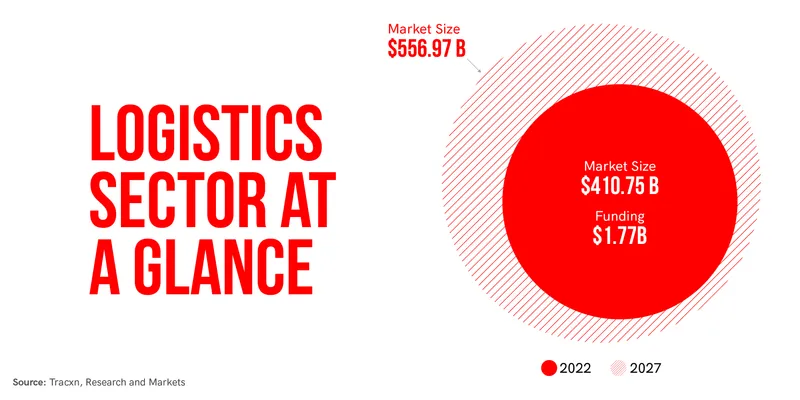The logistics industry hopes the National Logistics Policy will not only address the challenges impacting the industry, but also boost India’s trade competitiveness and create increased investment opportunities in the sector.
They believe, the policy, if implemented well, can usher in a tech-enabled ecosystem with optimised resource utilisation and improved connectivity and last-mile delivery—leading to overall improvement in productivity.
The logistics sector in the country is largely unorganised and fragmented, resulting in high logistics cost—14-15% of the GDP, compared to 7-8% in developed nations. There is also a high degree of wastage in the supply chain. For instance, 16% of India’s agricultural production is estimated to be wasted at different stages of the supply chain, according to the study ‘Assessment of Quantitative Harvest and Post-Harvest Losses of Major Crops and Commodities in India’ carried out by the Central Institute of Post-Harvest Engineering and Technology).
To address these challenges, the government introduced the National Logistics Policy (NLP) in September this year. The goal of the policy is to build a logistics ecosystem in India that is technology-enabled, integrated, cost-effective, and dependable. The policy also aims to create data-driven tools that help people make decisions for a better logistics environment.
Through the initiatives of the National Logistics Policy, the government intends to raise India’s global ranking in the Logistics Performance Index to 25, from 44 in 2018, and bring down logistics cost to 8% of GDP by 2030.
Ayesha Katgara, Head of Corporate Strategy, Jeena & Company, a logistics company, believes the National Logistics Policy is a “game changer” that India needs. “Right from the impact on infrastructure and connectivity, improving last-mile delivery, optimising resource utilisation, and encouraging private-sector investment, the NLP is poised to change the status quo,” she says.

Image credit: Nihar Apte
Streamline processes
The logistics sector in the country faces several challenges, including lack of infrastructure, inefficient modes of transport, lack of coordination among stakeholders, and increasing freight procurement and shipping costs.
Shashank Randev, Co-founder, 100X.VC, a venture capital firm, thinks the new policy can help address these challenges by creating a comprehensive logistics infrastructure and simplifying and streamlining customs processes. It can also facilitate coordination among various stakeholders, such as transportation companies, customs authorities, and warehouse operators, he says.
NLP proposes to create a single window portal, wherein service providers such as warehousing providers, shipping experts, transporters, and government agencies will be unified. This is expected to speed up approvals and certifications and reduce dependence on manual processes.
The policy will be supported by the PM’s Gatishakti National Master Plan to develop the requisite infrastructure and digital systems for the sector’s growth—resulting in faster and more efficient movement of goods and reduced delays and inefficiencies.
All this will gradually bring down the logistics costs to a single digit, says Dhruv Agrawal, COO and Co-founder, Shipsy, a SaaS-based smart logistics management provider.

Image credit: Nihar Apte
Harness technologies
For long, the absence of data-driven decision-making and inaccurate shipment ETAs have been weighing down India’s logistics sector. Use of technologies such as robotics as a service, artificial intelligence, cloud automation, blockchain, and big data can help address this challenge, and the new policy is geared towards harnessing such intelligent technologies and specialised software.
Zaiba Sarang, Co-founder, iThink Logistics, says, using specialised software will help third-party logistics providers increase their return on investment. It will also help save money and time and increase productivity. Improved speech recognition software will enable workers to interact directly with the warehouse management system, she says.
The Integrated Digital System and Unified Logistics Interface Platform of the logistics policy are expected to improve collaboration and visibility of goods for supply chain decision-makers. “It will automate negotiations and customs processes, facilitate greater use of multimodal transportation, and connect a business with multiple vendors to help drive cost-efficient logistics operations,” states Dhruv.
The policy also aims to create a data analytics centre for driving transparency and continuous monitoring of key logistics metrics.
Green initiative
The draft logistics policy lays emphasis on the shift towards more energy-efficient means of transportation and greener fuels to reduce the supply chain’s carbon footprint. It also focuses on boosting the usage of multimodal transportation and complementing it by building multimodal logistics parks.
“This will empower businesses to tap into lesser-used and more sustainable logistics modes, such as inland waterways and railways, to execute logistics operations that will result in lesser carbon emissions,” explains Dhruv.
Investment opportunities
Ultimately, improved efficiency in the logistics sector will result in higher profitability and returns on investment.
“Increased demand for logistics services can improve the competitiveness of Indian goods in the global market, providing a positive outlook for investors,” says Shashank of 100X.VC.
Outlook for 2023
Buoyed by the National Logistics Policy, the outlook for the logistics sector appears positive.
Growth in logistics infrastructure is expected to create massive job opportunities and eventually support the economic growth of the country.
Pratip Majumdar, Partner at Inflexor Venture, says, “With GDP growth, logistics will grow with a multiplier effect and play a key role in the manufacturing growth expected under the PLI (Production Linked Incentive) scheme.”
The supply chain and logistics sector, in the coming year, will become more adaptable and resilient to external economic factors, according to Nishith Rastogi, Founder and CEO of Locus, a logistics technology startup.
Here are some key trends that could shape the logistics sector in the coming year and beyond and help India become a global logistical hub, as highlighted by industry players and observers.
- The upcoming years will see greater use of new-age technologies, such as AI, ML, and automation, to optimise and automate core logistics processes.
- Businesses will focus on sustainable operations by reducing the miles travelled per package, eliminating empty miles, optimising delivery routes for better resource utilisation, and lowering shipping costs and trip volumes.
- There will be continued investments in electric vehicles, parcel lockers (automated parcel devices that serve as alternative delivery locations for dense delivery zones), and route planning solutions.
- Given the growth in ecommerce and proliferation of retail channels, last-mile delivery will drive the growth of the logistics industry. The focus will be on making last-mile delivery more intelligent, responsible, and less reliant on human labour.



![Read more about the article [Jobs Roundup] Work with new messaging tech unicorn Gupshup with these openings](https://blog.digitalsevaa.com/wp-content/uploads/2021/04/gupshup-1617887800113-300x150.png)






